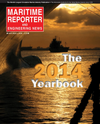
Page 22: of Maritime Reporter Magazine (June 2014)
Annual World Yearbook
Read this page in Pdf, Flash or Html5 edition of June 2014 Maritime Reporter Magazine
22 Maritime Reporter & Engineering News • JUNE 2014
BUNKER FUEL TRENDS
T he global shipping industry is no stranger to challenge or change. With responsibility for delivering 90% of global trade, it has had to continually demon- strate an ability to adapt. Now, with the implementation of increasingly stringent environmental regulations, which will increase operating costs and alter the dy- namic of fuel procurement, the industry will once again need to evolve.
In successfully responding to the intro- duction of the North American Emission
Control Area (ECA) in 2012, shipping has jumped a signi? cant hurdle, but this is just the beginning. The bunker market in the U.S. will encounter further change on several fronts, each with its own chal- lenges. However, with the right strategy and foresight, there are opportunities for all parties.
Energy Independence
The U.S. is moving towards increased energy independence much faster than most opinion formers had initially an- ticipated, with national energy self-suf- ? ciency a realistic prospect in the near future, maybe even by 2020. In the main, this is due to the exponential growth in shale oil production, which will affect the market for fuel oil, and alter the bunker market dynamics in the region.
Given the improved capabilities for shale oil extraction and transportation, as well as a rapidly growing domestic market for shale, the pattern of energy consumption, and indeed energy import and export to and from North America, is changing.
North American re? neries are unlikely to invest in the production of fuel oil along the U.S. Gulf Coast, as it would not be as pro? table in terms of operat- ing expenditure and returns. Shale oil crudes are lighter in nature and when re? ned will produce less fuel oil from domestic production, which could re- duce availability in what is already a limited domestic market. For shipping, this raises important questions about the future supply and demand balance of required fuels and what this means for ensuring compliance when the ECA sul- phur emissions limit drops to 0.1% in
January 2015. Fuel distributors must be cognizant of these market changes and need to work closely with their custom- ers to implement an effective plan that determines their fuel requirements both in North American waters and interna- tionally, and source quality products accordingly. With the right strategy and forward planning a fuel procurement strategy can be implemented for custom- ers that ensures compliance, and supply, and also protects the bottom line.
Widening of the Panama Canal
While there are well-reported chal- lenges with the construction project that will widen the Panama Canal, once com- pleted, the changes to vessel traf? c pass- ing through the canal may also impact the bunker market in the US. The third lock will increase the draft capacity of the canal signi? cantly to allow for Post
Panamax vessels, meaning the amount of cargo passing through the canal will increase. However, the number of ves- sels transiting along the canal may re- duce, along with the level of congestion at ports and canal entrances, which cur- rently fuels a large part of the demand for bunkers in the U.S.
Upon the project’s completion, we may see increased demand for fuel at East
Coast ports, which are being dredged and expanded with new berths to cater for larger vessels. Fuel distributors here may bene? t from the increase in feeder traf- ? c from the larger vessels at both sides of the canal as well as those operating from ports that have invested in dredging and expanding berths to cater to larger vessels. The West Coast bunker market, in comparison, will have to adjust and create a competitive offering to maintain traf? c, which is of course bene? cial to customers. West Coast ports would argue that it is cheaper to land in the region and then transit containers cross-country by land or rail. Along both coasts fuel dis- tributors must work with their customers
U.S. Bunker Market
Seizing Opportunities in a Rapidly Changing Market
BY ADRIAN TOLSON
MR #6 (18-25).indd 22 5/28/2014 12:13:22 PM

 21
21

 23
23
